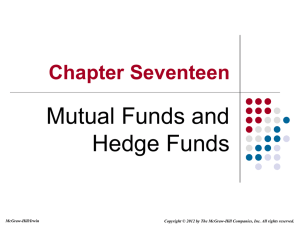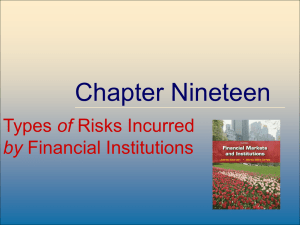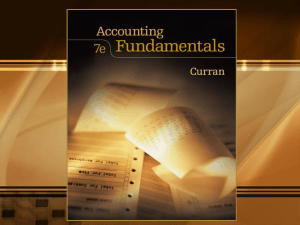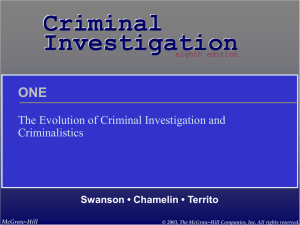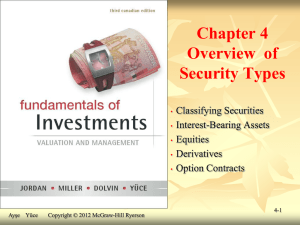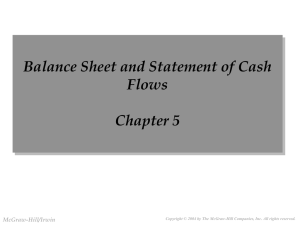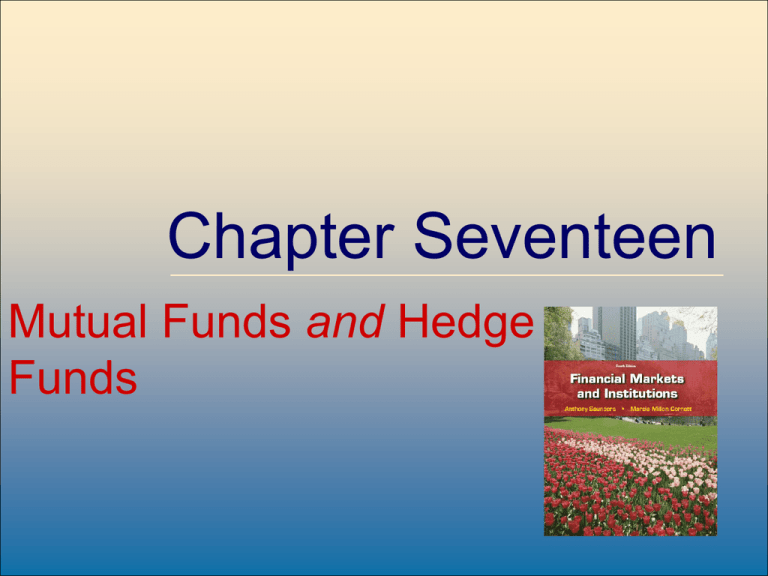
Chapter Seventeen
Mutual Funds and Hedge
Funds
McGraw-Hill/Irwin
8-1
©2009, The McGraw-Hill Companies, All Rights Reserved
Mutual Funds and Hedge Funds
• Mutual Funds (MFs) and Hedge Funds (HFs) are
financial institutions (FIs) that pool the financial resources
of individuals and companies and invest those resources in
portfolios of assets
• The first MF was established in Boston in 1924
• By 1970 360 MFs held about $50 billion in assets
• Money market mutual funds (MMMFs) were
introduced in 1970
• Tax-exempt MMMFs were introduced in 1979
• By 2007 more than 8,000 MFs held over $12 trillion in
assets
McGraw-Hill/Irwin
17-2
©2009, The McGraw-Hill Companies, All Rights Reserved
Mutual Funds
• Cash flows into MFs is highly correlated with the return
on the NYSE
• Growth has also resulted from the rise in retirement funds
under management by MFs
– MFs managed ~ 25% of retirement fund assets in 2007
• MFs are the second most important group of FIs as
measured by asset size, second only to commercial banks
• Banks’ share of all MF assets has grown to 21% in 2007
• Insurance companies managed 10% of MF industry assets
in 2007
McGraw-Hill/Irwin
17-3
©2009, The McGraw-Hill Companies, All Rights Reserved
Mutual Funds
• The barriers to entry in the MF industry are low
– the largest MF sponsors have not increased their
market share recently
• the largest 25 MF companies managed 76% of industry assets
in 1990
• the largest 25 MF companies managed 71% of industry assets
in 2007
– the composition of the top 25 firms in the industry has
changed
• seven of the largest 25 firms in 2007 were not among the top
25 in 1990
McGraw-Hill/Irwin
17-4
©2009, The McGraw-Hill Companies, All Rights Reserved
Mutual Funds
• The MF industry has two sectors
– short-term funds invest in securities with original
maturities of less than one year
• money market mutual funds
• tax-exempt money market mutual funds
– long-term funds invest in portfolios of securities with
original maturities of more than one year
• equity funds consist of common and preferred stock
• bond funds consist of fixed-income capital market debt
securities
• hybrid funds consist of both stock and bond securities
McGraw-Hill/Irwin
17-5
©2009, The McGraw-Hill Companies, All Rights Reserved
Mutual Funds
• Approximately 25% of long-term funds are index funds
– index funds are funds in which managers buy securities in
proportions similar to those included in a specified major index
– index funds involve little research or management, which results
in lower management fees and higher returns than actively
managed funds
• Exchange traded funds (ETFs) are also designed to
replicate market indexes
– traded on exchanges at prices determined by the market
– management fees are lower than actively traded funds
– unlike index funds, ETFs can be traded during the day, sold short,
and purchased on margin
McGraw-Hill/Irwin
17-6
©2009, The McGraw-Hill Companies, All Rights Reserved
Mutual Funds
• Money market mutual funds (MMMFs)
provide an alternative investment to interestbearing deposits at commercial banks
– bank deposits are relatively less risky, because they are
FDIC insured, and generally offer lower returns than
MMMFs
• Households own the majority of MFs
– owned 69.6% of long-term funds in 2007
– owned 46.0% of short-term funds in 2007
– 48.0% of all U.S. households owned MFs in 2006—
which represents ~56.3 million households
McGraw-Hill/Irwin
17-7
©2009, The McGraw-Hill Companies, All Rights Reserved
Mutual Funds
• MF managers must specify their funds investment
objectives in a prospectus, which is made
available to potential investors
– holds lists of the securities invested in by the funds
– in 1998 the Securities and Exchange Commission
(SEC) mandated that prospectuses must be written in
“plain English” instead of overly legal language (i.e.,
legalese)
McGraw-Hill/Irwin
17-8
©2009, The McGraw-Hill Companies, All Rights Reserved
Mutual Funds
• Equity funds represent 56.7% of MF assets in 2007 (~$5.9 trillion)
– capital appreciation funds (25.9%)
– world equity (12.6%)
– total return (18.2%)
• Hybrid funds represent 6.3% of MF assets (~$0.7 trillion)
• Bond funds represent 14.4% of MF assets (~$1.5 trillion)
–
–
–
–
–
–
–
corporate bonds (2.6%)
high-yield bonds (1.5%)
world bonds (0.6%)
government bonds (1.9%)
strategic income bonds (4.3%)
state municipal bonds (1.5%)
national municipal bonds (2.0%)
McGraw-Hill/Irwin
17-9
©2009, The McGraw-Hill Companies, All Rights Reserved
Mutual Funds
• Money market funds represent 22.6% of MF assets ($2.4 trillion)
– taxable funds (19.1%)
– tax-exempt funds (3.5%)
• Four of the five largest MFs in the U.S., as of February 6, 2008, were
managed by the same company
– American Funds Growth;A
• a growth fund with $91.4 billion in assets
– American Funds CWGI;A
• an international fund with $83.0 billion in assets
– American Funds CIB;A
• an income fund with $81.6 billion in assets
– Fidelity Invest: Contra
• a growth fund with $80.9 billion in assets
– American Funds InvCoA
• a growth/income fund with $73.5 billion in assets
McGraw-Hill/Irwin
17-10
©2009, The McGraw-Hill Companies, All Rights Reserved
Mutual Funds
• Investor returns from MF ownership reflect three
components
– income and dividends on portfolio assets
– capital gains on assets bought and sold at higher prices
– capital appreciation on assets held in the fund
• MF assets are usually marked to market daily
– prices are adjusted daily to reflect changes in the current market
prices of the portfolio’s assets
• Then net asset value (NAV) of a MF share is equal to the
market value of the assets in the MF portfolio divided by
the number of shares outstanding
McGraw-Hill/Irwin
17-11
©2009, The McGraw-Hill Companies, All Rights Reserved
Mutual Funds
• An open-end MF is a fund for which the supply
of shares is not fixed but can increase or decrease
daily with purchases and redemptions of shares
• A closed-end investment company is a
specialized investment company that has a fixed
supply of outstanding shares, but invests in the
securities and assets of other firms
• A real estate investment trust is a closed-end
investment company that specializes in investing
in mortgages, property, or real estate company
shares
McGraw-Hill/Irwin
17-12
©2009, The McGraw-Hill Companies, All Rights Reserved
Mutual Funds
• MFs charge investors fees for the services they provide
– sales loads
– 12b-1 fees are fees related to the distribution costs of MF shares
• cannot exceed 1% of average annual net assets for load funds
• cannot exceed 0.25% of average annual net assets for no-load
funds
– MFs may offer different share classes with different combinations
of loads
• A load fund is an MF with an up-front sales or
commission charge that the investor must pay
• A no-load fund is an MF that does not charge up-front
sales or commission charges on the sale of mutual fund
shares to investors
McGraw-Hill/Irwin
17-13
©2009, The McGraw-Hill Companies, All Rights Reserved
Mutual Funds
• MFs are heavily regulated because they manage and invest
small investor savings
–
–
–
–
The SEC is the primary regulator
The Securities Act of 1933
The Securities Exchange Act of 1934
The Investment Advisers Act and Investment Company Act of
1940
– The Insider Trading and Securities Fraud Enforcement Act of
1988
– The Market Reform Act of 1990
– The National Securities Market Improvement Act (NSMIA) of
1996
McGraw-Hill/Irwin
17-14
©2009, The McGraw-Hill Companies, All Rights Reserved
Mutual Funds
• Even with heavy regulation, investor abuses still
occur
– market timing is short-term trading that profits from
out-of-date values on the securities in the fund’s
portfolio
– late trading involves buys and sells long after prices
have been set at 4:00 pm E.T.
– directed brokerage occurs when brokers improperly
influence investors on their fund recommendations
– improperly assessed fees occur when brokers trick
customers into thinking they are buying no-load funds
or fail to provide discounts properly
McGraw-Hill/Irwin
17-15
©2009, The McGraw-Hill Companies, All Rights Reserved
Hedge Funds
• Hedge funds (HFs) are investment pools that solicit funds
from wealthy individuals and other investors (e.g.,
commercial banks) and invest these funds on their behalf
– similar to MFs, but not required to register with the SEC
– subject to virtually no regulatory oversight and thus generally can
(and do) take significant risk
– do not have to disclose their activities to third parties and thus
offer a high degree of privacy
• HFs avoid regulation by limiting the number of
investors to less than 100 and by requiring investors to
be “accredited”
– accredited investors have net worth over $1 million or annual
income over $200,000 if single (or $300,000 if married)
McGraw-Hill/Irwin
17-16
©2009, The McGraw-Hill Companies, All Rights Reserved
Hedge Funds
• HFs use more aggressive trading strategies than
MFs such as short selling, leverage, program
trading, arbitrage, and the use of derivatives
• Because HFs are not registered, they cannot be
accurately tracked
~ 9,000 HFs in the U.S. in 2008
~ $2.8 trillion in assets in 2008
~ new assets flow in at a rate of about $300 billion
annually
~ the 100 largest HFs control about 70% of the industry
in 2008
McGraw-Hill/Irwin
17-17
©2009, The McGraw-Hill Companies, All Rights Reserved
Hedge Funds
• There are three basic types of HFs
– the most risky HFs use market directional trading
strategies, seek high returns using leverage, and invest
based on anticipating events
– moderate risk HFs have a market neutral (or value)
orientation that favors longer-term investment
strategies
– risk avoidance HFs take a market neutral approach
and strive for consistent returns with low risk
McGraw-Hill/Irwin
17-18
©2009, The McGraw-Hill Companies, All Rights Reserved
Hedge Funds
• Management fees on HFs are computed as a percent of
assets under management and run between 1.5% and 2%
• Performance fees give fund managers a share of any
positive returns earned
– the average is 20%, but performance fees vary substantially
depending on the HF
– a hurdle rate is a benchmark that must be realized before a
performance fee can be assessed
– a high-water mark is when a manager does not receive a
performance fee unless the value of the fund exceeds the highest
NAV it has previously achieved
• Offshore HFs are attractive to investors because they
provide anonymity and are not subject to U.S. taxes
McGraw-Hill/Irwin
17-19
©2009, The McGraw-Hill Companies, All Rights Reserved
Hedge Funds
• HFs are exempt from registration requirements set forth
by the Investment Company Act of 1940
– HFs have less than 100 investors each, accredited investors, and
are sold only as private placements
• HFs are prohibited from abusive (i.e., illegal) trading
practices
• In 2003 the SEC recommended that large HFs register
with the SEC as investment advisors
– approximately 25% of HFs were already registered
• In 2007 the U.S. Treasury, the Federal Reserve, the SEC,
and the CFTC concluded that current HF regulation was
sufficient
McGraw-Hill/Irwin
17-20
©2009, The McGraw-Hill Companies, All Rights Reserved

